- Home
- Peter Matthiessen
The Cloud Forest Page 14
The Cloud Forest Read online
Page 14
We went on, up a marvelously eroded road, like a deep trench in the red clay; on both sides of the road were deep canyons of erosion, in the clefts of which tall century plants bloomed like huge asparagus. The banks of these canyons are full of burrows, and these are inhabited by small parrots; at our approach the parrots tumbled out and went squalling away down the canyon. From the top of the road, one could look back on Orizona, nestled in the broad fronds of its banana trees, under its yellow spires. Around it and beyond lay the green, rolling open range of Goiás.
After supper one night we walked down through the village to talk to a farmhand and his wife; in kerosene light, the family sat on the doorsill of their hut, still and neat as a row of birds, their feet bare on the clean-swept earth of the floor. They talked shyly with soft, vague gestures. The woman seemed twice her husband’s age, as women do here; on the man’s salary of forty cents a day there isn’t much to eat, and most of what there is is given to the man, to keep his strength. Many of the women in the villages have goiters, due apparently to a lack of iodine in the diet. The only women who eat quite well are the prostitutes, who are numerous even in this village; the poverty and an excess of women give them little choice about their line of work, even if they wanted one.
At another hut, the following day, I watched an old woman carding cotton and weaving it into string; this is a soothing process and endlessly amazing. A simple grace prevails here, in the postures of children waiting for nothing in the doorway, the young girl breast-feeding her baby, the old man in the corner with hands folded in his lap—the grace of people who have never gone anywhere and will never go. Only their grief is ungraceful, as perhaps grief should be: the villagers crowded and gawked around a dead baby done up in a little pink casket, its purple-gray tiny fingers twisted together in the clasp of prayer, and wild flowers stuffed in around it. All must have seen dead babies a hundred times before, and will see a hundred again—there were two in Orizona just today—and still they come and gawk. And yet it is hard to comprehend that something which has never lived can die—one stares at it with a certain awe, moved and revolted, and the revulsion has nothing to do with the spectacle itself. For some reason, I associated the dead baby with a little boy I had seen earlier on the far side of the village, at the Templetons’ Bible class. This boy wore striped shorts cut from an old pair of pajamas, and his head had been shaved bald to rid him of vermin, and his older brother, who was singing next to him, rested his arm on the bald head. They were singing a song about trains and God which involved saying “toot, toot” as a kind of chorus, and the bald boy’s “toot, toot” was said with great eagerness, so that his head would pop out from beneath his brother’s arm, but it was always a second or two behind the others’ and very wistful. It may well be that I was in a vulnerable frame of mind, but in any case I found him heartbreaking. Every time he said, “toot, toot,” he would glance wide-eyed around with his sharp little face, like a nervous weasel, and on one of these occasions he caught me smiling at him. I have never seen a smile like the one that appeared on that ugly little face in all my life—he was beside himself with excitement. He just knew I liked him, that was all, and that was plenty, to judge from the reaction. And it is the implications of this need of his that upset me, that caused me to make the arbitrary association between this child and the dead baby, as if their fates were identical in the end. It was a confusing day, during the course of which my soul was prayed for, and my safety, and the hope was expressed that my stay in Orizona would prove a blessing to me—I kept thinking of Albert Camus, with not quite such sympathy as usual, and without coming to any conclusion, either.
That evening, under the bare, weak electric bulb in the whitewashed room where Clayton conducts his “meetings,” I thought about the advantage held by the Catholic Church here, if only in the pomp and trappings of their services: all that ruby and gold and candlelight and satin must seem exalted after the bareness of a thatch hut (just as, to one sated by the glut of American things, the austerity of a Fundamentalist service seems preferable). Clayton uses only a bare table—there is no symbol anywhere in sight, not even a cross—and accompanies hymns on a small harp not unlike a zither, pausing now and again to speak or let one of the congregation read a prayer; on this particular evening Margaret Powell, a missionary on leave from the Caraja Indians of the Araguaya River, gave an interesting talk on mission work with that tribe, the women of which she referred to invariably as “ladies.” I sat in the rear, observing the congregation; most of the people were women, and there were also some uneasy young people, a number of children, an idiot, and a few dogs. It was hard to know what to make of the whole business, except that the Templetons took the villagers and their poverty seriously, and the villagers knew it.
On Monday afternoon, after three pleasant days in Orizona, I returned to Anápolis with Clayton and his son, preparatory to flying up in a missionary plane to the settlement on the Araguaya; we traveled by bus to the station at Eginereu Teixera and along the roadside saw two of the small emu, or ostrich, about the size of a thin turkey. Later, from the train, I glimpsed a bird which I feel certain was the white-tailed kite, a lovely pale hawk which I had seen only once before, in California. Shortly thereafter the train came to a long halt because a freight train ahead of it had jumped the track. This is not a serious calamity on this line: the trains do it as regularly as toys, and for very similar reasons. It is simply a matter of bringing up a repair crew from somewhere or other and going to work with big jacks and rerailers. After a few hours we walked down the line and observed the work (we also observed that, where the wheels had jumped, no one had bothered to spike the rails to the crossties; the rails had simply splayed under the weight), enjoying the cool night air and the smell of cigarettes and damp earth and smudgepots. Nobody was in much of a hurry, and we completed the hundred miles to Anápolis at two a.m., about twelve hours after we started off. Clayton says this is only slightly worse than average, worse because there were two train crews to botch up the rerailing instead of one; ordinarily it is the train which one is on which jumps the track.
At the airstrip, early the next morning, George Glass, the missionary-pilot, asked me to lead him and the Templetons in the prayer usually offered in these planes before a flight over the wilderness. I refused, rather too abruptly, saying I did not feel qualified, and afterward felt a sudden sense of being cut off from the others and at loose ends, so to speak. How serene these people are—as if religion were a state of shock, deep, peaceful shock, that good men like these are driven into by the spectacle of reality. Or is it that we, on the far side of the same abyss, do not wish to relinquish our tiny identities to a higher power? At least, I don’t, and I’m just as aware as the next man that temporal ambitions are insane—not because we are immortal, though, but because we are so mortal, and because our ambitions will amount at best to a hill of beans.
A ground fog was spread out below, airy as carded cotton (my amazement at carded cotton was apparently still with me today), and the ridges of the planalto jutted out of it almost angrily under the early sun; the clouds spun away down to the eastward, a white river. The shadow of the Cessna on these clouds was ringed like a bull’s-eye in an extraordinary round rainbow—we were traveling in a halo, but, to my relief, nobody remarked on the implications of this. Slowly the fog was burning off, and some large coffee plantations rose on the slopes below. There were miles and miles of them, and in an intervening valley the Rio das Ahmas—River of Souls—flowing subterranean in the valley fogs. Then we slid slowly down across the low, flat country to the north of the planalto, and the campos grew gradually more wet. Even the forests reflected light as we crossed that angle of the sun. Here and there a lonely hut and yard—what possesses a man to trek out here so far, when so much wild land lies so much closer to the roads?—and an occasional small band of pale cattle. The stream courses were jungly and palm-strewn. In time the land changed to open swampland—this is still the rainy season, and the rivers a
re in flood—gleaming below in the stagnant places with all the turgid browns and purples that one sees at the edge of an oil slick. From the southwest the Araguaya wandered toward us, unassertive in this seasonal world of water: we crossed its eastern fork and moved out over the Isla Bananal. The sun’s reflection crossed with us and knifed through the forest: because the ground is wet, the sun appeared to illumine the forest from below. On a rise at the river edge stood the hut of a Javahe Indian and a corral. This tribe is semi-civilized—that is to say, in peaceful contact with their white brethren.
George Glass dropped the plane low over the jungle, and we careened across the treetops, over creeks and swamp and tangled, evil sloughs. Then there appeared a broad flooded savanna, spotted with low trees and squat dwarf palms and an occasional pair of large white storks, the jabiru, or tuiuu, with its black head and cleaver bill and a scarlet slash across the neck; there were also egrets and caracaras and a flock of dark ducks—they looked long-legged and long-necked, like tree ducks. Deer—fat copper-colored deer—in ones and twos. A pair, the buck beautifully antlered, stood half submerged in a shallow pool, like moose.
Glass swung the plane across the river—we were now on the western branch—and we flew a while on the Mato Grosso side before crossing again to the island and dropping into the rough jungle airstrip at Macauba. The mission settlement at Macauba lies at the north end of Bananal Island, near the junction of Goiás, Mato Grosso, and Pará; from here the latter state extends northward across the Amazon. The huge island itself is formed between two branches of the Araguaya, which join again not far from here, some two hundred and ten miles north of where they parted. The Indians of the island are the Carajas and their sub-tribe, the Javahes; they are river Indians, and their villages, or aldeas, are scattered along hundreds of miles of the Araguaya. One of the largest of the aldeas is the one at Macauba; there are about eighty Indians here, a certain number of whom ran out through the jungle to greet the plane at the airstrip.
The Carajas, like most of the jungle tribes, are short, but they are handsome and friendly and are readily distinguished from Indians of all other tribes by the circles under their eyes—a small, exact black circular line the diameter of a quarter, tattooed under each eye, on the cheekbone. Some of them wear other facial marks as well—red and black stripes across the face—but the tattoos are disappearing among the young as the Carajas grow civilized. And all but the small children, in this missionary village at least, are clothed; most of the men wear shirts and a brief kind of shorts, and the women calico. The Indians also have elaborate, if scanty, costumes of bark cloth and feathers, but these are now saved for ceremonial occasions; some of the children, however, are clad in a necklacebib of beads, and both children and unmarried boys customarily wear thongs at the ankle and below the knee, and a large bracelet or gauntlet at the wrist. Otto Austel, the young missionary who came out to the airstrip with them, was dressed in blue sport shirt, brown trousers, checked socks, and black shoes. All these people, regardless of race, color, or creed, were delighted to see George Glass, who, as the pilot of the rare plane bringing distraction to Macauba, is invariably the hero of the hour.
The Indians led us to the settlement on the river bank, where the aldea is split in two by the small white buildings of the missionaries; out on the river a Caraja in the dark, rakish log canoe of the Amazon basin slid past with the current. The Indian huts are made of palm fronds draped on a pole framework; the fronds come from the babassu, which supplies as well the material for their weaving, the edible palm heart, and an oil from the babassu nut for use on skin, hair, and comestibles. The earthen floors are loosely covered with palm mats, and fires, pots, piles of fruit, baskets, squash and manioc, fish, mortars and pestles, chickens, dogs, and babies comprise the greater part of an organized litter; on the poles hang clothing, more baskets, arrows, bows, an aged rifle, perhaps, and one or more araras and parrots. The brilliant araras, or macaws—the rare hyacinthine, the scarlet, and the blue and yellow species of this great noisy long-tailed parrot are all found here—are usually moth-eaten in appearance; taken from the nest at an early age, and a symbol of Caraja wealth, they are plucked too regularly by their owners for feathers to use in arrows, earrings, caps, female loincloths, and male wrestling belts, and for supplementary decoration of bows, lances, gourd rattles, dolls, and war clubs, and for their striking “sunray” headdress. Feathers are used lavishly on the costumes and artifacts of their long festival, or ijaso, and on those to be sent off upriver, where tamer Carajas, with inferior workmanship, are starting a thriving tourist trade; already the airport shop at Goiania is littered with feathered trash, some of it no more Caraja than the feather duster. The Carajas are thought to be the most colorful tribe in Brazil, and before too long their craft will be as popular with Brazilian tourists as the Navaho blanket in the United States—unless the poor birds give out, which some of the prized species show every symptom of doing in this area. The pink feathers of the flamingo are considered the most valuable, but these birds, like the plumed egrets, are becoming difficult to obtain, and already the chicken is putting in an appearance in some of the poorer work.
Tattered “sun” headdresses were still visible in some of the huts, but the ijaso, lasting about three months and celebrating an obscure fish, had recently come to an end; the village, in fact, was rent at both ends by the wails of mourners. “My child is dead, is dead by witchcraft”—this is the ritual chant and is vented for hours at a time, usually by an old woman facing the hut wall in one corner, whether or not the family is mourning a child or even a death. Witchcraft and medicine men are very important in the life of the Carajas and constitute the chief obstacle which the missionaries must deal with in their work of illumination.
If anybody is equipped for this work, however, it is Otto Austel, a young man who has spent several years with these people, has studied them with the close eye of the anthropologist—he has a complex file on Caraja mores and customs—and speaks their glottal tongue very efficiently. In regard to his work, Austel sadly concedes that the exposure of a primitive tribe to missionaries, however successful—because of the care, generosity, and devotion of the missionaries, the tribe is almost always benefited at the outset—is followed more often than not by its extinction, through the subsequent exploitation, mixed breeding, alcohol, and disease that arrive not with the advent of the Word but with civilization. He is trying to persuade his mission to work with tribes already laid open to civilization, who actually need help more than those unreached; help, however, is secondary in the end to the salvation of souls (“Do you know that three out of every four people in the world have not heard that God loves them?”), and the missionaries eventually move on to more dramatic work, leaving the now vulnerable tribe to the tender mercies of the traders and settlers. How long the Indian soul stays “saved,” under the circumstances, is a question difficult to answer, but a missionary I talked to elsewhere told me of a tribe on the Tocantins which, over the years, has had a succession of faiths, both Catholic and Protestant, squabbling over its souls and can no longer tell one from another; as a result it has become cynical and indifferent to the lot, assuming that the missionary of the moment will in the end forsake them, like all the rest. And whatever the reasons, the Indians of South America (the large agricultural civilizations of the Andes excepted) continue to decline in number: in 1845, one hundred thousand Carajas were thought to exist, but a half-century later these had been reduced to about ten thousand, and today there are two thousand at most, the Javahes included. This ratio of decline is probably about average for the jungle tribes of South America, many of which are already extinct.
According to Austel, however, the Carajas are presently holding their own and even perhaps increasing. Formerly they were nomadic beach families and groups, depending almost exclusively on fish, which are shot with arrows, harpooned (in the case of the huge pirarucu), and poisoned with barbasco; they also hunt wild pig, turtles, and birds, though the latter are k
illed primarily for their feathers. But nomadic hunters who “gather” to survive are always limited in number, and the missionaries have encouraged the Carajas toward vegetable plantations. This group, at least, grows its own manioc, squash, corn, sweet potatoes, and bananas, supplemented by the fruit of such wild trees as the caja and the jatoba; they have made a beginning at raising their own cattle of the scrubby Brahma cross which does well in the lowlands.
The first afternoon at Macauba I went to see the Indian plantations and the jungle. The forest, even the river forest, of Goiás and Mato Grosso is not true rain forest, for the trees here are not enormous, nor do they form a solid canopy above: they are woods, as the name “Mato Grosso” suggests. (Mato grosso means “thick woods,” but this isn’t quite correct, either, since much of the state, like Goiás, is wild, grassy range country, supporting scattered shrub and bushes.) A hundred miles to the northward, in the state of Pará, the trees on the river banks are already tall, spreading gradually to unbroken rain forest where the Araguaya joins the Tocantins. Nevertheless, the jungle here is impressive, and some of the piqui and jacoba trees are very large indeed. There is also a variety of palms, including the macauba; the lumber tree known as “cedar,” the landi, which is hollowed out to make canoes, and the rare Brazilwood tree for which the country was originally named. On the ground, in open places where a rock of volcanic aspect protrudes through the thin soil, there is a pretty weed with small purple flowers, like clover; though the plant is not insect-eating or otherwise endowed, its leaves are sensitive to the slightest touch, which causes the whole plant to fold in upon itself, swoon dead away. It comes around again in a little while, but the most delicate passage through it of a cat would leave a clear wake of bent brown stems among the green.

 Lost Man's River: Shadow Country Trilogy
Lost Man's River: Shadow Country Trilogy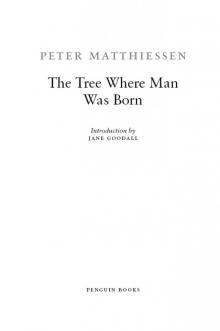 The Tree Where Man Was Born
The Tree Where Man Was Born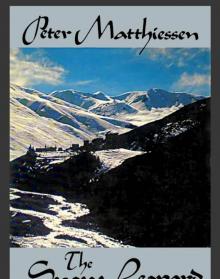 The Snow leopard
The Snow leopard Sand Rivers
Sand Rivers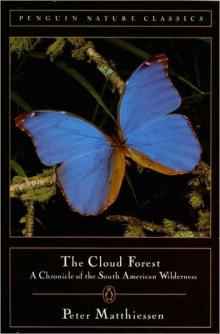 The Cloud Forest
The Cloud Forest Sal Si Puedes (Escape if You Can)
Sal Si Puedes (Escape if You Can) Far Tortuga
Far Tortuga Men's Lives
Men's Lives On the River Styx: And Other Stories
On the River Styx: And Other Stories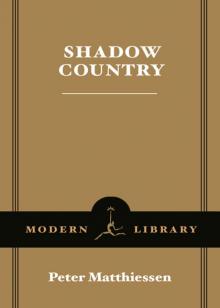 Shadow Country
Shadow Country At Play in the Fields of the Lord
At Play in the Fields of the Lord Lost Man's River
Lost Man's River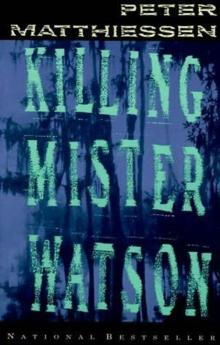 Killing Mister Watson
Killing Mister Watson On the River Styx
On the River Styx